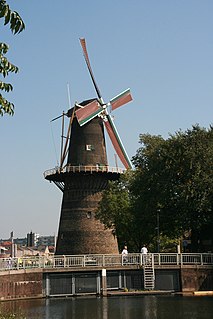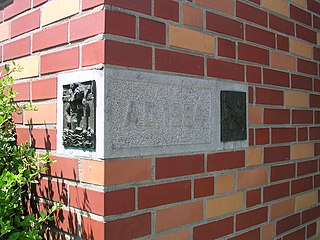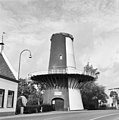
Heckington Windmill is the only eight-sailed tower windmill still standing in the United Kingdom with its sails intact.

Alford Windmill is a five-sailed windmill in Alford, Lincolnshire and the only surviving windmill out of four. Today the windmill has been restored to working order, and grinds grain to organic flour. It is open as a tourist attraction.

Durrington or High Salvington Windmill is a Grade II listed post mill in High Salvington, Sussex that has been restored and is in full working order. The mill stands 320 feet (98 m) above sea level and is able to take advantage of incoming sea winds.

A tower mill is a type of vertical windmill consisting of a brick or stone tower, on which sits a wooden 'cap' or roof, which can rotate to bring the sails into the wind.

Consuegra is a municipality located in the province of Toledo, Castile-La Mancha, Spain. In 2009 the municipality had a population of 10,932 inhabitants. It is 80 km from Ciudad Real and 60 km from Toledo. Consuegra is located in La Mancha region, famous for its extensive dry plains, vineyards and historical constructions such as their windmills.

De Noord is a windmill located on the Noordvest 38 in Schiedam, Netherlands. It is the tallest windmill in the world with a roof height of 33.3 metres. Its wing span is 26.6 metres. The mill is one of the five remaining windmills in Schiedam, and is a national monument since 29 May 1969. Today De Noord houses a restaurant.

De Otter is a paltrok mill in Amsterdam, North Holland, Netherlands which has been restored to working order. As all Dutch paltrok mills it is a windpowered sawmill. The mill is listed as a Rijksmonument, number 1198.

The Torenmolen van Gronsveld is a tower mill near Gronsveld in the municipally of Maastricht, the Netherlands, which is still in working order. The mill was built in 1623 and is listed as a Rijksmonument, number 28086. It is the most southerly windmill in the Netherlands and the oldest of the province Limburg.

De Hoop ("Hope") is a flour windmill in Ouddorp built in 1845 and fully renovated in 1984. It is one of the few windmills in the Netherlands that is still privately owned, and is still in full commercial operation.

Aan de Pegstukken is a windmill located on De Pegstukken 27 in Schijndel, North Brabant, Netherlands. Built in 1845 on an artificial hill, the windmill functioned as a gristmill. The mill was built as a tower mill and its sails have a span of 25.25 metres (82.8 ft). The mill is a national monument since 19 September 1973. The name of the mill comes from the street it is located on.

De Adriaan is a windmill located on the Windmolen 17 in Meerveldhoven, a neighbourhood of Veldhoven, North Brabant, Netherlands. Build in 1906 on an artificial hill, the windmill functioned as gristmill. The mill was built as a tower mill and its sails have a span of 26.20 meters. The mill is a national monument since 1 October 1969.

The Molen van Aerden is a windmill located on the Raadhuisstraat 28A in Nispen, Roosendaal, in the province of North Brabant, Netherlands. Built in 1850 on an artificial hill, the windmill functioned as gristmill. It was built as a tower mill and its sails have a span of 23.80 metres (78.1 ft). The mill is a national monument since 19 May 1971. The Molen van Aerden can be visited by appointment.

De Akkermolen is a 17th-century windmill in Zundert, Netherlands. Built around 1605 to replace an earlier windmill, it was used as a gristmill until it was severely damaged in 1950. The mill was bought by the local government and restored in 1961, and it was listed as a national heritage site in 1974.

De Arend is a windmill located on the Akkerstraat 11 in Wouw, Roosendaal, in the province of North Brabant, Netherlands. Built in 1811 on an artificial hill, the windmill functioned as a gristmill. The mill was built as a tower mill and its sails have a span of 25.85 metres (84.8 ft). The mill is a national monument since 24 June 1971.

The windmills at Kinderdijk are a group of 19 monumental windmills in the Alblasserwaard polder, in the province of South Holland, Netherlands. Most of the mills are part of the village of Kinderdijk in the municipality of Molenwaard, and one mill, De Blokker, is part of the municipality of Alblasserdam. Built in 1738 and 1740, to keep water out of the polder, it is the largest concentration of old windmills in the Netherlands and one of the best-known Dutch tourist sites. The mills are listed as national monuments and the entire area is a protected village view since 1993. They have been a UNESCO World Heritage Site since 1997.

De Windhond is a windmill in the city of Woerden, Netherlands. The mill was built in 1755 on an artificial hill of 9.3 metres (31 ft) in height that was part of the defensive enclosure (stadswal) of the ancient city. The mill itself is 5.7 metres (19 ft) high. The windmill sail spans 25.2 metres (83 ft).

Ramløse Windmill is a smock mill located in the northeastern corner of Ramløse, Gribskov Municipality, North Zealand, some 60 kilometres (37 mi) north west of Copenhagen, Denmark. Built in 1908, it remained in service until 1937. The mill has been restored to working order and is operated by a group of local volunteers six times a year. One of the other buildings at the site, a former workshop, has been turned into a small museum which exhibits historic tools used by different trades. There is also a B&B and a café.

Old Buckenham Windmill is a tower flour mill which stands in the village of Old Buckenham, Norfolk, England. It is a Grade II* listed building, notable for being the largest diameter windmill in the country.

Zeldenrust is a smock mill in Oss, Netherlands.




























